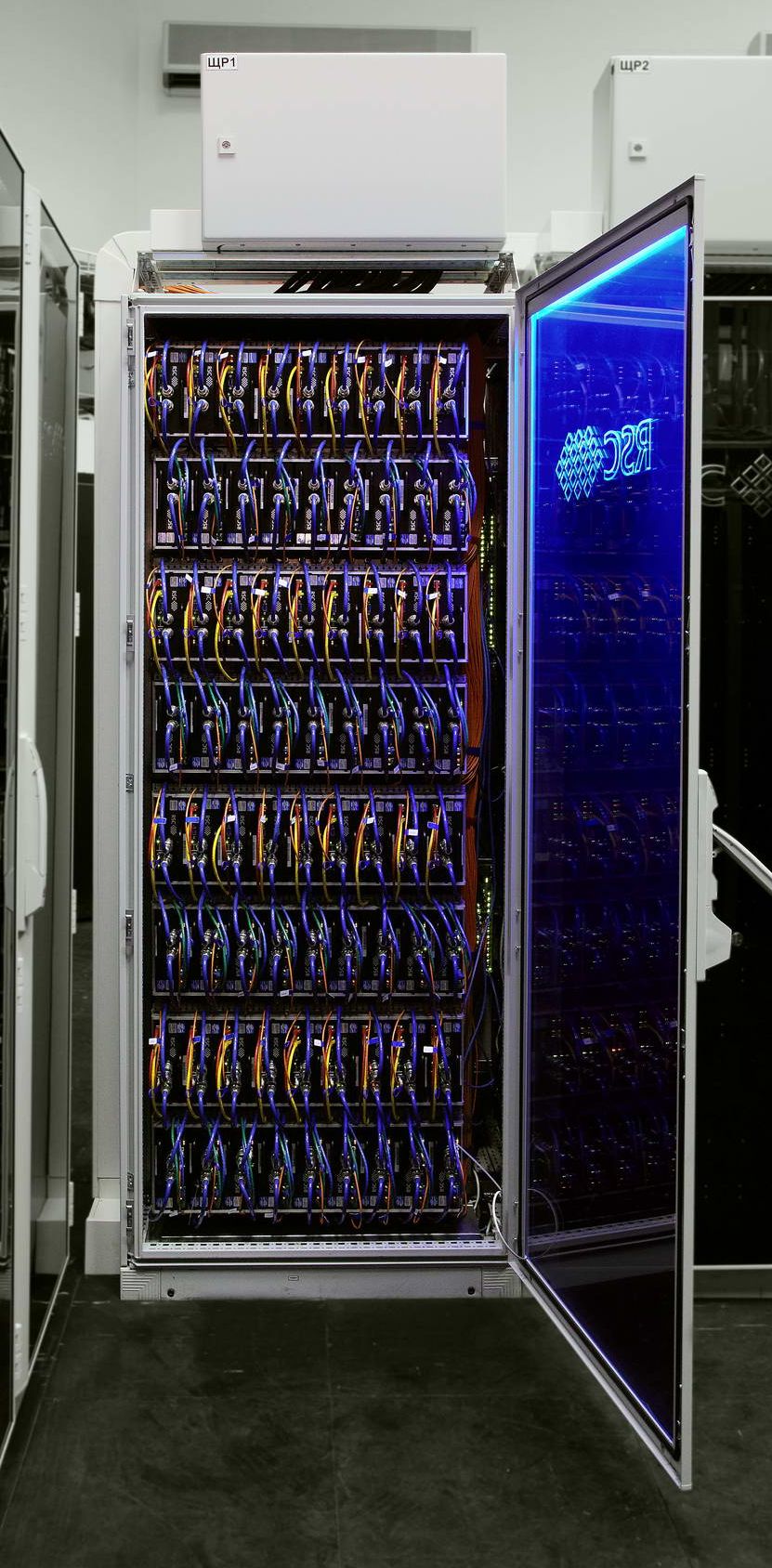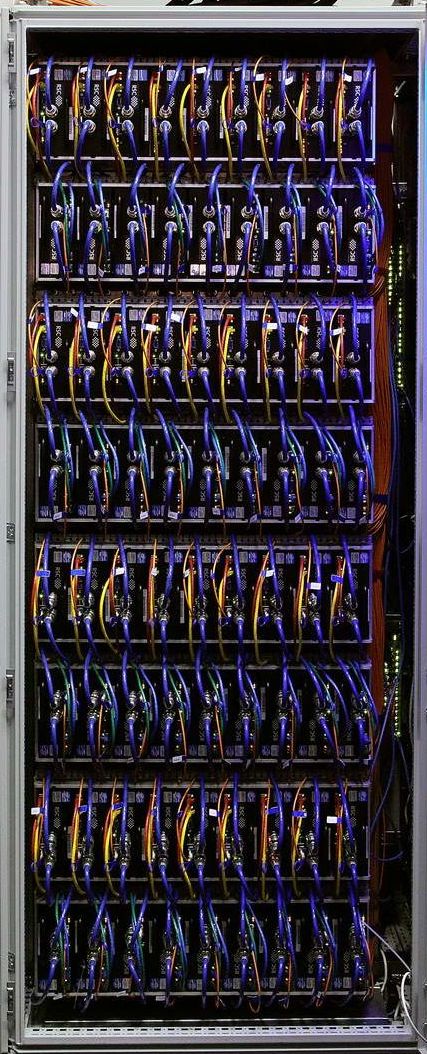SC12, Salt Lake City, November 12, 2012. – At SC12, the International Conference for High Performance Computing, RSC Group (booth #4721), the leading Russian and CIS full cycle developer and HPC solutions provider, has demonstrated a prototype of a 10 PFLOPS-range (PFLOPS is quadrillion floating point operations of double precision per second) supercomputing system at the Joint Supercomputer Center (JSCC) of the Russian Academy of Science (RAS). MVS-10P supercomputer based on RSC Tornado architecture is the Russia’s, CIS and Europe’s largest system with the latest Intel® Xeon Phi™ coprocessors. The new supercomputer at JSCC has set several records in different nominations. The prototype system with direct liquid cooling and 523.8 TFLOPS (trillion floating point operations of double precision per second) peak performance sets the Russia’s and CIS energy efficiency record level of more than 1,680 MFLOPS/W, which is 4.8 times increase comparing to the previous energy efficiency record for the region (also achieved by an RSC Tornado-based system with liquid cooling).
The use of an advanced liquid cooling system allows reaching industry’s highest computing density of 181 TFLOPS per 80*80cm*42U rack, or 141 TFLOPS/m3, which is 3.8 times higher than the previous world record for х86 architectures. Such a high computing density is required for ExaFLOPS-range supercomputers, which will consist of hundreds of racks each consuming over 100kWatt of power. The unique power and performance density levels achieved by MVS-10P prototype system based on RSC Tornado architecture proves technical feasibility of building high-performance systems with required characteristics for ExaScale era.
The supercomputer consists of 3,328 Intel® Xeon® E5-2690 processor cores and 25,376 Intel Xeon Phi coprocessor SE10X cores. Each node supports a large capacity of energy efficient RAM – 64 GB (DDR3-1600, low voltage green memory), which equals to 4 GB per each Intel Xeon core and 13 TB of RAM for the whole system. A high-performance interconnect is based on advanced FDR Infiniband technology (56 Gbps). The new supercomputer at JSCC is also equipped with a flexible power and energy management RSC ECOsystem technology which additionally decreases the total cost of ownership (TCO) by 25%. The RSC ECOsystem technology was first demonstrated by RSC Group at the leading European supercomputing show ISC’12 in Hamburg and deployed in the MVS-10P supercomputer for the first time.
“The new JSCC supercomputer is Europe’s, Russia’s and CIS largest system with the latest Intel Xeon Phi coprocessors. The use of Intel Xeon Phi in RSC Tornado architecture allows us to improve energy efficiency record in Russia and CIS countries also owned by RSC. The energy efficiency increased 4.8X times reaching more than 1,680 MFLOPS/W. It became possible due to the combination of two unique technologies – an energy efficient direct liquid-cooled RSC Tornado architecture and Intel Xeon Phi coprocessors for high-performance applications, which allowed us to set the current world record in energy efficiency among х86 systems.”, said Alexey Shmelev, COO at RSC Group.
Joint Supercomputer Center (founded in 1999 and having branches in St. Petersburg and Kazan) is one of the most powerful supercomputing center providing high-performance computing services in Russia for scientific and educational institutions. JSCC employs highly skilled scientists, programmers and engineers. The center provides its services to over 100 organizations; 181 research groups work in the center with more than 900 tasks in fundamental and applied areas.
JSCC's main objectives are:
• supporting scientific research in the Russian Academy of Sciences institutes with modern computing and telecommunication resources;
• providing methodology to researchers that need high-performance computing systems and information processing tools; helping prepare highly qualified scientific specialists;
• providing access to modern digital libraries, archives, databases and data collections;
• performing research in the development of system and application software, as well solving highly complex tasks.
“The new powerful supercomputer MVS-10P based on RSC Tornado architecture will triple the performance of JSCC’s computing complex, allowing to achieve some unique characteristics in performance, energy efficiency and manageability, supports the research and solving of cutting-edge supercomputing tasks and will help solve urgent and fundamental scientific problems at the Russian Academy of Science with the goal to further develop scientific and economic potential of Russia.”, said academician Gennady Savin, RAS Presidium member, RAS JSCC General Manager.
“We are excited that the supercomputing project in JSCC has become the first in Europe and one of the first in the world to use the latest Intel Xeon Phi coprocessors. The marriage of technology from RSC, JSCC and Intel has achieved breakthroughs in energy efficiency, computing density and performance. Improving supercomputing performance and programmability on the path to Exascale is a global challenge, and we are honored to be participating in the strategic Russian system.”, said Raj Hazra, Vice-President Intel Architecture Group, GM Technical Computing Group.
Unique characteristics of RSC Tornado-based solutions
The new stage in development of innovative RSC Tornado architecture for energy efficient data centers and supercomputing systems allowed RSC Group’s specialists to implement world's first direct liquid cooling for widely available Intel® Xeon®-based standard server boards (from various manufacturers), initially designed for traditional systems with air cooling of electronic components, with the latest Intel Xeon Phi coprocessors. This is the third generation of RSC’s energy-efficient solutions for High Performance Computing, cloud environments and data centers.
Powerful solutions with high computing density based on RSC Tornado architecture with direct liquid cooling are designed to solve various customers’ needs. The product line includes RSC DCmicro (16 to 64 nodes), RSC DCmini (64 to 256 nodes) and RSC Data Center (from 2 high dense racks up to dozens of PFLOPS).
Among unique features of RSC Tornado architecture and solutions there are the following:
• Up to 128 х86 servers in a standard 42U rack 80х80х200 cm;
• High-density blade server design based on widely available boards;
• Record-breaking energy efficiency. The system allows achieving an industry-leading Power Usage Effectiveness (PUE) of less than 1.06 (the ratio of total amount of power used by a computer data center facility to the power delivered to computing equipment.). This means that maximum 5.7% of the consumed energy by a datacenter will be used for the cooling of the system;
• Record-breaking computing effectiveness ratio — more than 96% for Intel Xeon E5-2690 processors in LINPACK benchmark (Intel® Turbo Boost Technology is always on, which provides for clock speed gain of up to 400 MHz in LINPACK);
• Removal of over 100 kW of power from each rack using RSC’s unique liquid cooling design;
• Possibility to use Intel's top-performing server processors with heat dissipation of 135W, e.g. Intel Xeon E5-2690 Processor (2.9 GHz, 8 cores) and the newest highest performing Intel Xeon Phi coprocessors;
• High peak performance – over 47 TFLOPS per rack based on Intel x86 architecture with AVX Instruction set and up to 181 TFLOPS with the use of Intel Xeon Phi coprocessors;
• High density – 74 TFLOPS per square meter (using Intel Xeon only) and 283 TFLOPS per sq. m (with Intel Xeon Phi coprocessors);
• High scalability – up to PFLOPS level (dozens of racks);
• Cost effectiveness – operating cost reduction by 60 percent (energy cost saving due to RSC solution operation);
• Compact size – multifold datacenter floor area reduction comparing to traditional air-cooled installations;
• Fully integrated software stack for High Performance Computing – RSC BasIS optimized for high performance computing.





